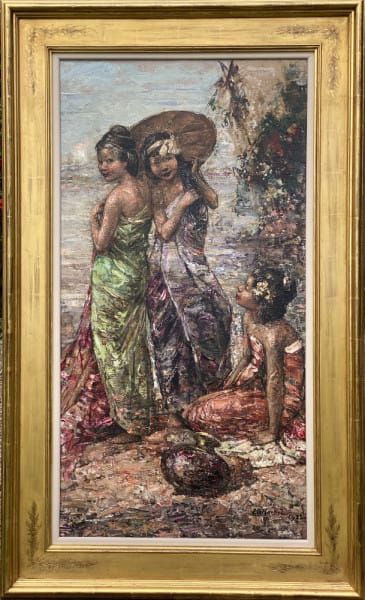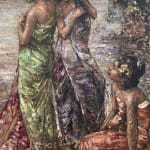Edward Atkinson Hornel Scottish, 1864-1933
Burmese Girls by the Sea
Oil
Size without frame: 35 x 18 inches
Size with frame: 43 1/2 x 26 1/2 inches
Size with frame: 43 1/2 x 26 1/2 inches
Visualise On Your Wall
Born in Bacchus Marsh, Victoria, Australia, died in Kircudbright on 30 June 1933. Both parents were Scottish and came to Britain at the age of two, settling with his parents in Kirkcudbright. Studied at the Trustees Academy, Edinburgh, 1880-1883 and at the Academy in Antwerp in the company of W.S.MacGeorge under Verlat from 1883-1885. He studied at the Academy in Edinburgh with James Pryde and DY Cameron among his contemporaries while his classmates included Denholm Armour and the Greenock artist Peter Kerr. While still a student he painted a little woodland scene, handled with some freedom and already showing an emphasis on two dimensional pattern, which still exists. In 1883 ‘A View of Kircudbright’ painted the previous year appeared in the RSA. His work in Belgium confirmed his development in a broad landscape style, showing the influence of Jacob Maris and Anton Mauve. In 1885 he met George Henry and formed a friendship which was to influence both of them for the rest of their lives. The two shared a studio in Glasgow and painted alongside one another in Kirkcudbright for several years before travelling to Japan together in 1893-4. They developed a highly original style which concentrated on flat colour pattern detracting from any emphasis on the subject. A rich impasto, low-key palette was the result and with minor variations remained his distinctive style making the paintings instantly recognisable. An early example of the mature style, before the arrival of the Japanese paintings with their expressionistic rhythms and powerful colouring, is ‘The Dance of Spring’; Hardie finds a marked similarity between Hornel’s curious, grotesque, ‘The Brownie of Blednoch’ 1899 and the Belgium expressionist James Ensor’s early work. The Japanese paintings of 1893-94 are generally regarded as the artist’s apotheosis. After his return we find an uncertain self-consciousness and the early signs of mannerism which detracted so much from his later work. ‘The little girls become increasingly coy and well-behaved, the palette sweeter, the composition mechanical, and the figures static .. yet his remarkable sense of colour rescued many of his later paintings from banality’ (Hardie). He enjoyed travel, visiting Ceylon in 1907, Burmah and Japan again in 1922. He continues to be an intensely popular Scottish artist and for many collectors it remains a social cachet to possess a Hornel.
Elected ROI in 1904, having declined ARSA in 1901; member of the Society of 25 Artists.
Exhibited at the RSA, RA, RSW, ROI, GI, and AAS. His work is represented in many public and private collections.
Born in Bacchus Marsh, Victoria, Australia, died in Kircudbright on 30 June 1933. Both parents were Scottish and came to Britain at the age of two, settling with his parents in Kirkcudbright. Studied at the Trustees Academy, Edinburgh, 1880-1883 and at the Academy in Antwerp in the company of W.S.MacGeorge under Verlat from 1883-1885. He studied at the Academy in Edinburgh with James Pryde and DY Cameron among his contemporaries while his classmates included Denholm Armour and the Greenock artist Peter Kerr. While still a student he painted a little woodland scene, handled with some freedom and already showing an emphasis on two dimensional pattern, which still exists. In 1883 ‘A View of Kircudbright’ painted the previous year appeared in the RSA. His work in Belgium confirmed his development in a broad landscape style, showing the influence of Jacob Maris and Anton Mauve. In 1885 he met George Henry and formed a friendship which was to influence both of them for the rest of their lives. The two shared a studio in Glasgow and painted alongside one another in Kirkcudbright for several years before travelling to Japan together in 1893-4. They developed a highly original style which concentrated on flat colour pattern detracting from any emphasis on the subject. A rich impasto, low-key palette was the result and with minor variations remained his distinctive style making the paintings instantly recognisable. An early example of the mature style, before the arrival of the Japanese paintings with their expressionistic rhythms and powerful colouring, is ‘The Dance of Spring’; Hardie finds a marked similarity between Hornel’s curious, grotesque, ‘The Brownie of Blednoch’ 1899 and the Belgium expressionist James Ensor’s early work. The Japanese paintings of 1893-94 are generally regarded as the artist’s apotheosis. After his return we find an uncertain self-consciousness and the early signs of mannerism which detracted so much from his later work. ‘The little girls become increasingly coy and well-behaved, the palette sweeter, the composition mechanical, and the figures static .. yet his remarkable sense of colour rescued many of his later paintings from banality’ (Hardie). He enjoyed travel, visiting Ceylon in 1907, Burmah and Japan again in 1922. He continues to be an intensely popular Scottish artist and for many collectors it remains a social cachet to possess a Hornel.
Elected ROI in 1904, having declined ARSA in 1901; member of the Society of 25 Artists.
Exhibited at the RSA, RA, RSW, ROI, GI, and AAS. His work is represented in many public and private collections.
Join our mailing list
McEwan Gallery Newsletter
* denotes required fields
We will process the personal data you have supplied in accordance with our privacy policy (available on request). You can unsubscribe or change your preferences at any time by clicking the link in our emails.






